Part Two of a 12 part guide to Website optimisation
In Part 1, we explored how to use web analytics to benchmark performance and drive insight through data which is a theme throughout this series of in-depth articles. We continue this theme in this guide where I will look at approaches I use to review competitors. I hope you find the approaches interesting and I'll be interested to hear how they differ in the approaches and tools you use.
Competitor research is a core part of optimisation and involves studying websites that rank well for keyword targets.
While it's common to think of which keywords you should target, it's less common to research competitors in detail. But I think this is really important since each keyword and industry can be vastly different in terms of what puts a website at the top of search results. For one search term it could be down to high quality inbound links, for another a large volume of social conversation created by the web owner.
Putting the time into competitor research is important for several reasons:
1. It benchmarks your SEO performance against the market
2. It highlights gaps in your keyword coverage
3. It helps identify content areas where you are weak
4. It shows keyword and content areas where you rank well and have competitive advantage
5. It provides insight to help you define realistic SEO targets
The most important output of competitor research is a greater understanding of what is helping websites to rank highly for keywords relevant to your website. It reveals areas of strength and weakness from which you can create an attack plan to ensure you focus your resource and efforts in the right areas.
I spoke to Freelance E-commerce Consultant Dan Barker for his take on the value of competitor research, having done this many times when E-commerce Manager and now even more times as a consultant:
"It’s amazing the amount of insight you can gather. From understanding gaps in your link profile, to finding individual links you may be able to pick up, to understanding your competitors’ comms plans & how they’re driving traffic, figuring out which keywords & groups they’re targeting, which products they’re launching, which agencies are involved, what their customers value/dislike about them, who their staff are, which customers are advocates, and much more.
It’s worth doing this kind of thing purely for the insights you get, but it’s even more valuable as part of a research phase for any big strategy/planning work. And if you do any of the more granular pieces of analysis, it’s very much worth analysing your own brand in the same way too. You almost always learn something, and occasionally you unearth giant dinosaur skeletons you wouldn’t otherwise have noticed."
The importance of ongoing competitor analysis
Getting the top search engine rankings is only half the battle; retaining them is equally challenging. Ongoing competitor analysis helps you identify what levers competitors are pushing to drive their SEO, helping you refine and improve your optimisation efforts.
Creating a competitor matrix for SEO
We recommend building a top-level matrix that compares your SEO presence with three or more key online competitors. This isn’t analysis per se but it will give you a quick snapshot of your current capabilities versus that of your competitors. It can also be the most effective way to prove to a client where they site in the market and the investment needed to improve results.
Option 1 – create your own from aggregated data:

Using aggregated data to build a competitor profile view for SEO
[Editors note: I often use a similar approach at the start of an analysis report for clients, but would look at unique linking domains, e.g. from the Majestic SEO tool) and also number of pages indexed. If you're unfamiliar with the main tools available for comparing backlinks, see our review by Chris Soames on competitor benchmarking tools for SE[relatedratings=null]O].
Option 2 – use a dashboard from an SEO tool like Open Site Explorer:
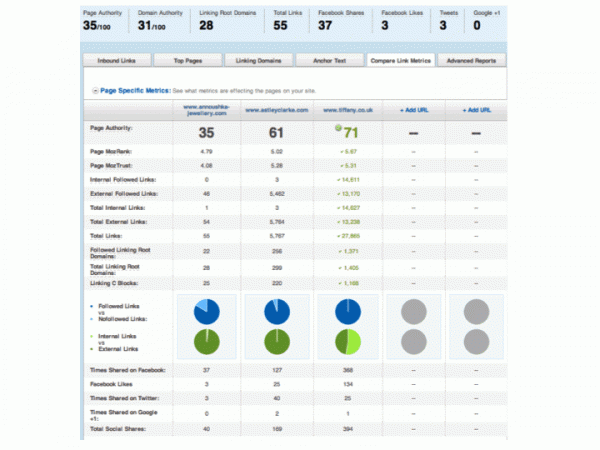
Using the Open Site Explorer Pro version from SEOMoz to analyse competitor SEO
Which competitors to review?
If you operate in a highly competitive market (think jewellery where the search competitor set changes based on type of search i.e. page one competitors for “diamond engagement rings” are different to those for “white gold pendants”), it’s unpractical to undertake an authoritative review of all possible search competitors. If you did that, you would never have time to do any optimisation.
To decide which competitors to review, ask yourself the following questions:
• What keywords do you currently rank for and who else is above you in search results?
• Which websites are the most prominent for short and mid tail keyword searches that you don’t rank well for?
• Which of these websites are most similar to what you offer?
• Which of these websites offers a competitive product/service?
• How important is local search to you?
Local search is hugely important for businesses covering specific geographies and where there is physical shop presence. In the US 40% of search queries have local intent – that’s 100m unique visitors per month.
What information should you review?
Local search
If you are a multi-channel retailer, your website can add search value by driving store traffic and revenue. To achieve this you need to ensure your webpages are optimised for local search. A core part of this involves looking at how effective other websites are at putting their webpages in front of local searchers.
Key pointers (based on optimising for Google as this still has >80% market share in the UK):
• Use the Google External Keyword Tool and Google Insight to identify trending local keywords
• Run searches in Google for these keywords and identify which websites are on page one for natural search (local and normal)
• Follow links to learn from what your competitors are doing – review Google Places listings, check landing pages, review local content on websites
• Compare your landing pages with your competitors – what do they do better?
Example: Local search for “diamond rings UK”
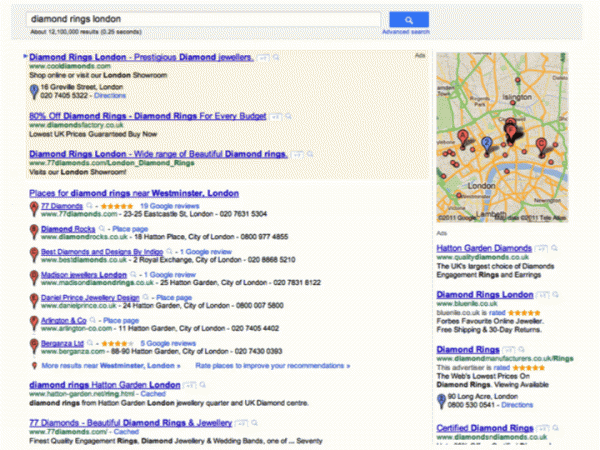
Reviewing which competitors have strong local search presence
A click through to 77Diamonds Google Places listing reveals:
• Full profile has been created
• 19 reviews all with 5 star rating (such glowing praise sometimes makes people question authenticity but it does boost visibility)
• Keyword target “diamond rings” is in the description
• Product photos have been added
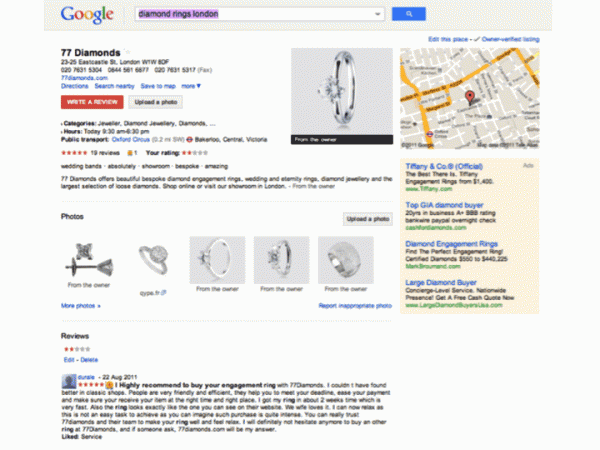
Optimising Google Places listings to support SEO
On-site optimisation
What structure do your competitors follow for their page titles and meta descriptions?
Page Titles
Page titles are probably the single most powerful on-site factor to assist with keyword targeting and rankings. Paying attention to and optimising page title formats across the site could have a significant cumulative impact on rankings.
There are three ways to review competitor page titles:
1. In search engine results, the page title is the underlined title (this is in blue, with matched keywords in bold)
2. On a webpage on your competitor’s website, the page title will display in the browser tab
3. On a webpage, mouse over part that is not clickable, right click on the mouse and select View Source, use the ctrl+F function and look for “title” – this will show you where the page title sits within the html code.
What are you looking for?
How effectively your competitor is optimising keyword inclusion in the recommended maximum 70 characters of the page title. Google cuts off the page title when it exceeds the character limit.
Once you have looked at how other websites do this, you can review your approach to page title optimisation and learn how to improve to ensure you have the most relevant keywords included.
Meta descriptions
Meta descriptions form the snippet used in the search result listing. They tend to not directly influence how well you can rank for a particular keyword but a well-written meta description can result in a more attractive listing and a better click-through rate. As such you should consider your Meta Description tags as your pitch to the Searcher as to why they should visit your site over any other.
Follow the same approach for meta descriptions, looking at what levers competitors use in this text to encourage searchers to click. There is no ‘right answer’ for optimising meta descriptions but identify the techniques used by your competitor set and evaluate your current copy in light of this. If you were searching, would your link make you want to click through?
External links
External links have always been important for SEO but following the recent Panda update, quality links are more important than ever in Google.
With Yahoo Site Explorer on its way out, you can use tools like the SEOMoz Open Site Explorer (free version but you get the investment in the Pro version adds a lot of value) to evaluate the linking domains associated with you and your competitors.
[Editor's note: Visualising the anchor text of backlinks is particularly important in competitive markets - aren't they all!? So on client projects we use Wordle to visualise the most important backlinks using data exported from SEOMoz. Patrick Altoft has a great summary here of using Wordle for competitor backlink analysis:
Advanced Link Building Strategies for Affiliate Sites - Patrick Atloft ]
Screenshot – view of linking domains to a competitor website from SEOMoz Pro version of Open Site Explorer
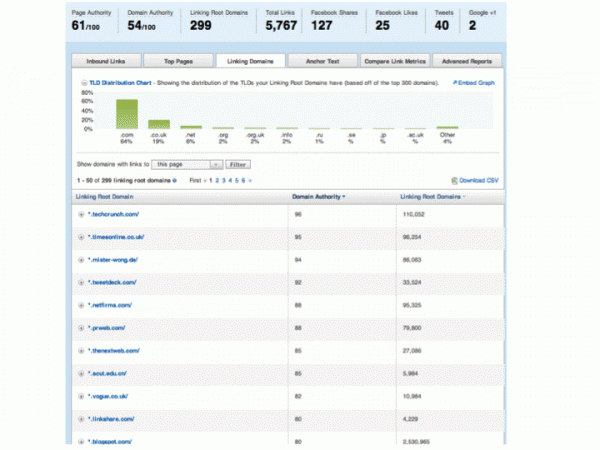
Using SEOMoz Pro version of Site Explorer to evaluate inbound links to competitor websites
Why do this?
A link adds the most value when it comes from a reputable domain, uses optimised anchor text for keyword relevance and deep links into the most relevant page on the website for the visitor.
You need to use the tools available to find the following:
• Which domains you currently get link juice from and how well optimised those links are (you can tally this up with data from Google Webmaster Tools and your web analytics to validate traffic volumes)
• Which domains are linking to your competitors from which you currently have no links?
• Which are the most valuable domains that you want to target to build new links to your webpages?
Content
Content also plays an important role in SEO. Customers and search engines like fresh content. Content can help customers to make decisions and achieve the goals for their visit with the secondary benefit of providing an opportunity for keyword rich copy to boost search engine visibility.
What do you need to do?
• Understand how your competitors use content across their websites
• Evaluate the use of blogs for producing content
• Look at how they link to purchase pages from the content pages
• Look at how they incorporate relevant keywords into the content
• Look at how content pages are integrated into site search results pages.
The site search factor may seem strange to you but there is a good reason – if content appears in search results, it will increase the number of clicks to those pages and drive customer engagement.
Keep an eye out for non transactional websites
Keep an eye out for websites that are informational and not transactional. If you’re an e-commerce site you could lose out on traffic because a blogger or content site has built a more compelling story that makes the search engines and searchers alike rate their website highly. These sites tend to be heavy on content, so they have greater opportunity for keyword inclusion on their websites. You may also find they have invested more time and effort in interactive content such as video.
Social media presence
Social signals are an important component of search engine algorithms. It’s often said that to be liked by Google, you need to be liked. Search engines have made great inroads into indexing real-time and social content, such as the Twitter firehose (over 50m tweets per day).
Given the global adoption of social media via key networks like Facebook, YouTube and Twitter, you need to understand what your competitors are doing in this space. A few pointers:
• What social networks do they have presence in?
• Are they incorporating social media content in their website e.g. live Twitter feed
• Are they creating video content and making this available via video sharing sites like YouTube?
• Do they make use of Slideshare for content sharing (usually more relevant to B2B than B2C marketers)?
• Are they active with their social networks? i.e. do they post regular new content, do they respond to customer, do they encourage discussions?
Create a competitor matrix to provide a snapshot of customer engagement via social media. This serves as your benchmark for your level of social media optimisation, which can be reviewed every month.
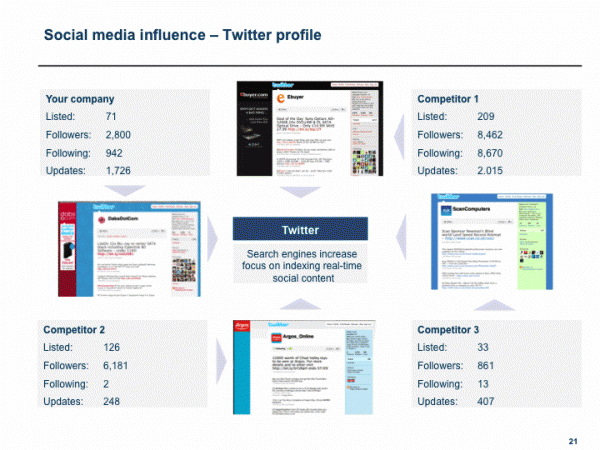
Comparing social media presence for SEO analysis
How to use your competitor analysis to influence SEO planning - keyword targets
You can’t go after everything; you need to pick your battlegrounds. If you are up against a huge brand it’s going to be very hard to make quick wins for generic short tail terms due to their brand heritage. For example, in the Health & Beauty market the superstores like Boots and Superdrug are dominant for the short tail terms like “health and beauty”, “beauty products” and “toiletries”. When you move away from bucket terms to keywords like “organic skincare” you see the competitor set changing to niche brands.
So the challenge is to identify targets (based on current search trends in relevant markets) where the level of competition is lower and you can drive quick gains with the resource available. For example, in the Health & Beauty sector you might choose the keyword target “natural skincare products” because the competitor set is easier to target – less inbound links, less content, lower domain authority etc.
Working with competitors
Remember that you need to keep an eye out for informational websites as well as product websites? Well, here’s a business opportunity. If you are an e-commerce manager, you can approach these websites and encourage them to link to relevant product pages. Focus on communicating the value you can add to their website as this usually drives a better response.
It's possible to work with these web owners via an affiliate program - either through an affiliate network or direct using your own tracking technology to reward the web owners for driving converting traffic.
Please share your comments and suggestions
So, this is Step Two in the Smart Insights 12 step series of website optimisation for natural search. It’s by no means an exhaustive list, more a steer in the right direction. Please join in the discussion with comments and your own experience of using competitor analysis to drive SEO insight. Keep an eye out for next month’s article, “Identifying high performing keywords for natural search”.
Missed Step One? Read my article on using web analytics to benchmark performance and drive insight through data.
Thanks
james












